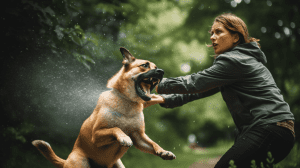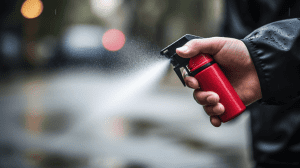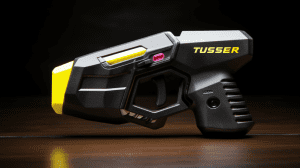Best Weapon to Defend Against Dog Attack
Dog attacks can be a terrifying experience and knowing how to defend yourself effectively is crucial to minimize potential injuries. With a growing concern for personal safety, it’s important to be informed about the best weapons to defend against dog attacks. There’s a wide range of tools and techniques available for protection, and understanding how to utilize them properly can make all the difference in a life-threatening situation.
Recognizing an aggressive dog’s behavior early can help you take action quickly and avoid a possible attack. The variety of defensive tools includes common items such as pepper sprays specifically designed for canines, ultrasonic dog repellers, and even using bright light to disorient and discourage an approaching dog. However, it’s essential to practice caution, prioritize distance and safety, and know the legal implications of using these tools in self-defense.
Key Takeaways
- Pepper sprays designed for canines are an effective tool for self-defense against dog attacks.
- Recognizing aggressive behavior early can help you react quickly and avoid potential injury.
- Maintaining distance and understanding legal implications of using self-defense tools can help ensure safety and responsibility.
Recognizing Aggressive Behavior

As someone who has encountered aggressive dogs, I believe it’s crucial to be able to recognize their behavior to make informed decisions in those situations. In my experience, an aggressive dog’s body language can offer significant clues about its intentions or state of mind.
When I observe a dog with stiff body posture or raised fur on its back, it’s usually a sign that the animal is feeling threatened or protective. Similarly, baring teeth or growling implies aggression and should be taken seriously. One must avoid making direct eye contact with an aggressive dog, as it may interpret this as a challenge or threat.
Another behavior I’ve witnessed in some aggressive dogs is lunging or charging, further emphasizing their intentions to attack. In these situations, maintaining a calm and assertive demeanour can be helpful in diffusing tension.
Being knowledgeable about aggressive behavior in dogs can facilitate a safer interaction with them and potentially prevent an unnecessary attack. By paying attention to their body language, I’ve been able to avoid getting bitten and, in some cases, even avoid escalating a situation with an aggressive dog.
Best Weapons for Defense
In my experience, one of the best weapons to defend against a dog attack is pepper spray formulated specifically for canines. Brands like Sabre Red and Mace offer products designed to stop aggressive dogs in their tracks.

Another effective option is a stun gun or stun baton. These devices deliver a non-lethal electric shock that can temporarily incapacitate an attacking dog. Just be sure to check local laws as some places may have restrictions on stun guns.
Personally, I find that walking with a stick or a baseball bat can provide a sense of security and a means to ward off aggressive dogs. Swinging or poking the stick or bat can create distance between you and the dog, potentially preventing an attack. However, it’s essential to use these items wisely and not to harm the animal unnecessarily.
While not a weapon, I believe knowing martial arts can be helpful for defending against dog attacks. Techniques like rotating your body sideways can make you appear smaller and less intimidating to dogs, preventing an attack before it even begins.
For those who prefer non-lethal weapons, consider the Taser Pulse or a pepper gun. Both of these devices offer a means of defense without causing lasting harm to the animal. Additionally, citronella spray can be effective in repelling dogs, and high-frequency sound devices may scare off canine attackers without causing harm.

Some dog owners carry break sticks to help separate their dog from another during a fight. These sticks can be inserted between the dog’s jaws to release their grip, potentially ending a dangerous situation.
In conclusion, there are a variety of weapons and techniques to defend against dog attacks. Be sure to choose the option that suits your preferences and needs while considering local laws and the safety of both yourself and the dog.
The Importance of Distance
When it comes to defending against a dog attack, maintaining a safe distance is crucial. I find it essential to keep enough space between myself and the dog to allow for reaction time and avoid close range encounters. In such situations, having enough distance can make a significant difference in the outcome and prevent potential injuries.
At a safe distance, I can effectively use tools like bright lights or high-pitched sounds to deter the dog from approaching further. For instance, a flashlight with a bright light can temporarily disorient the dog and give me an opportunity to escape or call for help. Similarly, a high-pitched sound emitted by devices like a dog whistle or even a personal alarm can be uncomfortable for the dog, causing it to retreat.
Moreover, staying at a safe distance allows me to observe the dog’s behavior and identify its intentions. If the dog appears aggressive or agitated, I can adjust my actions accordingly to protect myself and others around me. This also gives me enough time and space to utilize self-defense tools, such as pepper spray or stun guns, more effectively.
In conclusion, maintaining a safe distance during a potential dog attack is critical for personal safety. By keeping a healthy space between myself and the attacking dog, I can utilize various methods and tools more effectively while greatly reducing the risk of injury.
Usage and Effectiveness of Ultrasonic Dog Repellers
As someone who often encounters aggressive or unfriendly dogs during my walks or runs, I’ve found that ultrasonic dog repellers can be a relatively safe and humane means of keeping these animals at bay. These devices typically emit a high-frequency sound that is audible to dogs and cats but almost inaudible to humans, as explained by TBOTECH.
In my experience, I’ve found that ultrasonic dog repellers can distract an aggressive dog, drawing its attention away from me and giving me the chance to remove myself from the situation. One thing to keep in mind is that the effectiveness of these devices may vary depending on the dog’s breed, age, and hearing ability. Additionally, environmental factors such as wind, rain, or ambient noise may affect the sound’s propagation, potentially reducing its effectiveness.
Besides ultrasonic dog repellers, there are other devices that utilize loud noises to deter aggressive or attacking dogs. For instance, handheld dog horns can produce sharp noises that startle and repel dogs from a distance, as mentioned by Security Picks. These audible sound devices are a practical and non-violent way to protect oneself from dog attacks.
Using an ultrasonic dog repeller or an audible sound device doesn’t guarantee that a dog will immediately cease its aggressive behavior. However, I have found them to be useful tools to carry with me for added safety when encountering potentially dangerous situations involving aggressive dogs.
Training and Body Language
As someone who constantly strives to develop self-defense skills, I find it vital to understand and utilize the power of training and body language when encountering a potential dog attack. Dogs are incredibly perceptive animals, quickly picking up on body movements, tone of voice, and our overall energy. Therefore, it’s essential to remain calm, confident, and knowledgeable in their presence.
In my experience, observing canine body language is key to predicting and preventing dog bites. For instance, if a dog displays signs of aggression such as growling, baring teeth, or raised hackles, I take a neutral stance with my body slightly angled away from the dog. This position helps me appear less threatening while maintaining a clear line of sight to gauge its next move.
Maintaining a confident demeanor is paramount when facing a potential dog attack. Dogs can sense hesitation or fear through our body movements and vocal tones, so it’s crucial to remain assertive without becoming overly aggressive. One effective tactic I use is to firmly and loudly command the dog to “Stay!” or “Back!” while maintaining eye contact. This allows me to establish dominance and possibly deter the dog from advancing.
Finally, it’s important to remember that not all dogs are aggressive or dangerous. Many dogs may approach out of curiosity or simply to protect their territory. Understanding how a dog feels in a given situation can help us respond appropriately to their behavior. If a dog seems anxious or afraid, giving them space and avoiding sudden movements can prevent a potentially volatile situation from escalating.
Incorporating these principles into my self-defense training has helped me feel more confident, knowledgeable, and prepared in case of a dog attack. Recognizing the power of body language and effective communication with dogs allows us to navigate these situations safely and intelligently.
Using Bright Light as a Defensive Tool

In situations involving a potential dog attack, one effective method of defense is the use of bright light. This can disorient the dog and provide an opportunity for escape. A tactical flashlight is an ideal tool for this purpose, as it is both portable and designed for self-defense situations.
I’ve found that tactical flashlights often have a strobe feature that emits rapid bursts of bright light. This can be particularly useful when trying to disorient an aggressive dog, as the alternating light may confuse or startle them. Additionally, the intense brightness of a tactical flashlight can temporarily impair the dog’s vision, giving me valuable time to escape or call for help.
When using a tactical flashlight as a defensive tool, it’s important to aim the beam of light directly at the dog’s eyes. This will maximize the potential impact of the bright light and decrease the likelihood of the dog continuing its attack.
Another advantage of using a tactical flashlight for defense against dog attacks is that it allows me to maintain a safe distance from the animal. This is crucial, as getting too close to an aggressive dog can result in further provocation and the potential for more severe injuries. By shining the bright light from a distance, I can effectively deter an attacking dog without putting myself at increased risk.
In summary, a tactical flashlight with a bright light and strobe feature can be a highly effective tool for defending against aggressive dogs. By aiming the light directly at the dog’s eyes and maintaining a safe distance, I can minimize the threat and potentially avoid a harmful encounter.
Dog Bites and Immediate Medical Attention
In my experience, dog bites can range in severity from a minor scratch to a life-threatening injury. Regardless of the degree of the wound, it’s crucial to seek immediate medical attention to prevent infection, treat the injury, and minimize any long-term consequences.
In the aftermath of a dog bite, the first thing I would do is to clean the wound thoroughly with soap and water. This helps reduce the risk of infection by removing any debris or bacteria present. Then, I would apply an antibiotic ointment to the area and cover it with a sterile bandage. If the bite is deep or large, pressure should be applied to control bleeding before seeking professional help.
When it comes to medical attention, it’s essential to promptly visit a healthcare professional, even if the injury appears minor. They can assess the severity of the wound and determine the appropriate treatment. In some cases, stitches may be necessary to close the wound and minimize scarring. Tetanus or rabies vaccinations might also be recommended, especially if the dog’s vaccination history is unknown or if the dog was acting abnormally during the attack.
I have learned that dog bite injuries can lead to permanent damage if not properly treated. Complications such as infection, nerve damage, and loss of function in the affected area can occur if medical attention is delayed or inadequate. Therefore, it is vital to act quickly and prioritize the wellbeing of the person injured, even if the bite seems trivial at first glance.
In summary, treating dog bites and seeking immediate medical attention is crucial for preventing infections, minimizing permanent damage, and ensuring the best possible outcome after a dog attack. Remember to clean the wound, control bleeding, and consult a healthcare professional to ensure the proper care and treatment are provided.
Legal Perspective
When it comes to defending oneself against a dog attack in the United States, there are a few legal aspects to consider. In my experience, the best weapon to defend against a dog attack is pepper spray specifically formulated for canines. However, using a weapon to defend against a dog attack, especially a police dog, could lead to legal consequences.
As a law-abiding citizen, it’s crucial to understand that police dogs are considered law enforcement officers. Injuring or killing a police dog can result in legal action against the individual involved. When faced with an aggressive police dog, it is advisable to comply with the commands of the officer in charge, as resisting could escalate the situation further.
In cases where one has to defend oneself against a non-police dog, various states have different laws that outline the acceptable means of self-defense. To avoid potential legal issues, it is essential to be well-informed about the local regulations and statutes. For instance, some states may allow using a weapon to defend oneself against a dog attack, while others may not permit such actions. Therefore, seeking advice from legal professionals, such as personal injury attorneys, can be beneficial in understanding the specific rights and regulations in a given area.
On that note, if a person becomes a victim of a dog bite, they may be eligible to pursue legal action against the dog’s owner, depending on the jurisdiction. In most cases, the owner’s liability arises from negligence or violating local leash laws. However, for a successful legal claim, it’s crucial to prove that the owner was at fault and that the victim did not provoke the dog.
In summary, understanding the legal perspective is essential when defending oneself against a dog attack. A clear knowledge of local regulations and respective rights, coupled with appropriate self-defense measures and the assistance of legal professionals, can ensure the safety and protection of all parties involved.
Preventitive Measures and Best Practices
In my experience, the best strategy when dealing with potential dog attacks is to be proactive and practice preventive measures. As a dog owner myself, I understand the importance of being aware and educated on this topic. Here are some best practices to help you stay safe.
One of the first steps I take is to avoid approaching unfamiliar dogs, especially if they’re not leashed or accompanied by their owner. If I encounter an unleashed dog while walking my own dogs, I maintain distance and give them enough space to reduce the chance of any aggressive interactions.
When I see a dog approaching, a good thing to do is to assess their body language. An aggressive or fearful dog may have its hair raised, ears back, and may be growling or baring its teeth. If I notice any of these signs, I calmly change my direction or put something between me and the dog, such as a tree or car.
I’ve found that carrying a product like pepper spray specifically formulated for canines, such as Sabre Red or Mace, is a useful item to have on hand as a best defense option. In case of an approaching aggressive dog, I can use it to deter them without causing permanent harm.
Additionally, it’s important to be aware of the following best practices when faced with a potential dog attack:
- Do not run away: This may trigger the dog’s instinct to chase and attack. Instead, I try to remain calm and stand still, avoiding direct eye contact and keeping my hands by my sides.
- Make yourself appear larger: I’ve found that using direct, confident body language and raising my arms can make me appear larger and more intimidating.
- Distract the dog: If necessary, I’m prepared to use an object—like a shoe or bag—to distract or block the dog’s path. Throwing the object may buy me enough time to escape to a safe place.
Of course, there’s no foolproof method to completely prevent a dog attack, but following these guidelines has worked well for me. I remain confident and knowledgeable about my actions and remain vigilant to provide the best protection for myself and my dogs.
Frequently Asked Questions
What devices can protect me from a dog attack?
There are several devices that can help protect you from a dog attack. Some popular options include stun guns and pepper sprays. Stun guns deliver a high-voltage, low-current electrical charge to temporarily disorient the dog, while pepper sprays cause irritation and temporary blindness when sprayed into the dog’s eyes.
How to effectively use a dog defense stick?
A dog defense stick can be an effective tool for warding off an attack. To use it properly, maintain a firm grip on the stick and position yourself in a defensive stance. Aim for the dog’s most vulnerable areas like the head, throat, or ribs. Use the stick as a barrier between you and the dog, and strike only when necessary to prevent further aggression.
Where is the best place to strike an attacking dog?
When defending yourself against an attacking dog, it’s crucial to target the most vulnerable areas. Aim for the head, nose, or throat to cause the most damage and potentially deter the dog from continuing its attack. However, remember that your primary goal should be to create distance and escape, not to injure the dog.
What strategies can help me defend against a charging dog?
If a dog is charging at you, there are several strategies you can employ to protect yourself. First, stay calm and do not panic, as fear can make the situation worse. Do not make direct eye contact, as some dogs may interpret this as aggressive behavior. Position yourself sideways to appear smaller and less intimidating. Avoid running or screaming, which may trigger the dog’s predatory instincts.
Which weapon is most effective against a pit bull attack?
There’s no definitive answer to this question, as the effectiveness of a weapon will depend on the specific situation and individual dog. However, common defensive tools like stun guns and pepper sprays can be effective in many cases. Notably, though, using any weapon should be considered a last resort, prioritizing non-violent strategies like those previously discussed.
What items should I carry for protection against dog attacks?
For protection against dog attacks, consider carrying a few items like a dog defense stick, stun gun, or pepper spray. These tools can help you ward off an attack and give you time to retreat to safety. Additionally, always make sure you’re equipped with a phone to call for help if necessary.








